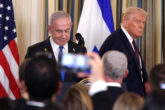December 06, 2018
Give Saudi Arabia a Take It or Leave It Deal
President Donald Trump released a statement on November 20 in which he supported Saudi Arabia’s Crown Prince Mohammed bin Salman’s (MBS) claim that he had nothing to do with the murder of Jamal Khashoggi, directly contradicting a leaked CIA assessment that MBS ordered the killing. Vowing to stand with U.S. ally Saudi Arabia, Trump cited lucrative foreign military sales and Iranian aggression among the reasons for his support. Saudi Arabia’s disastrous war in Yemen has been met with a similar absence of criticism from the administration. However, the United States should do more than wring its hands about this war that has killed thousands and brought many more to the brink of starvation, by applying pressure on Saudi Arabia to change its course. The question is how?
Walking away from supporting the Saudi-led war in Yemen and ending U.S. mid-air refueling might give Washington the moral high ground, but it will do little to stop the killing. The Saudis view the threat in Yemen as crucial to their interests, so U.S. pressure to end the war altogether will fall short of causing real change. To the Saudis, the threat of Iran establishing a foothold on their southern border is much more vital to their interests than procuring U.S. weapons. Rather than walk away from Yemen, they will buy Russian bombs or use less sophisticated weapons and tactics that will kill even more civilians. Americans will have washed our hands of a morally unacceptable situation, but civilian deaths and the threat of famine will actually get worse, and the world will look on and do nothing.
The only approach worse than walking away is what the United States is currently doing—giving the Saudis a blank check. Supporting the Saudis with intelligence, refueling, weaponry and minimal guidance on protecting civilians has failed at preventing civilian casualties. This policy was started by the Obama administration and put on steroids in the age of Trump. The theory was that by remaining engaged and involved, the United States could exercise some influence on Saudi Arabia and drive more responsible targeting and decision-making in Riyadh.
Read the full article in The National Interest.
More from CNAS
-
Transatlantic Security / Middle East Security
The Russia-Iran Partnership: A Geopolitical Balancing ActIt has been almost a year since Russia and Iran signed their comprehensive strategic partnership. That deal established a 20-year partnership between the two countries coverin...
By Andrea Kendall-Taylor & Jim Townsend
-
Transatlantic Security / Middle East Security / Energy, Economics & Security
Sanctions Aren’t Enough to Shut Down the Moscow-Tehran Black Market for WarThe geographic scope and extent of Iranian-Russian cooperation highlights the failure of traditional sanctions to prevent Moscow and Tehran from seeking key components like ch...
By Delaney Soliday
-
How a Peace Deal Between Hamas and Israel Will Reshape the Middle East
Rachel Brandenberg joins NPR to discuss how the region will change if Israel and Hamas continue to abide by the peace deal President Trump brokered. Listen to the interview o...
By Rachel Brandenburg
-
Donald Trump’s Gaza Plan Skips Step One
The White House proposal attempts to solve too many distinct issues all at once, without enough input from Palestinians....
By Delaney Soliday




